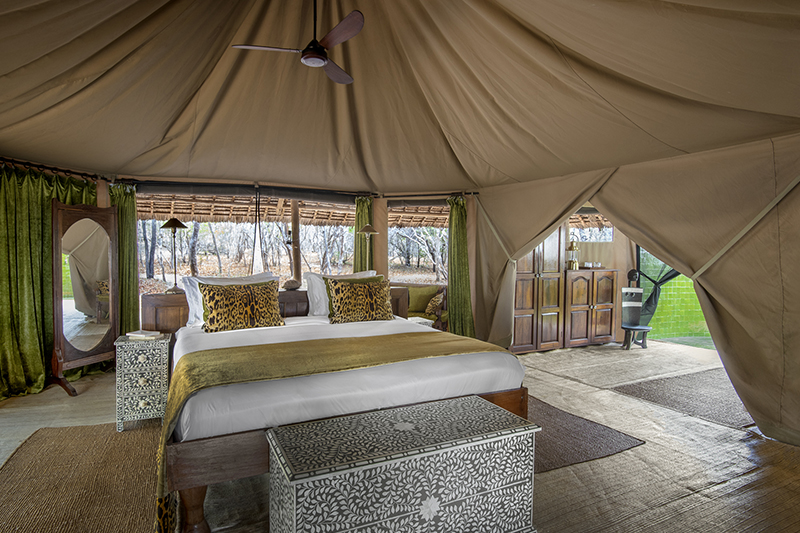Siwandu
Siwandu is a tented lodge located in a palm grove on the shores of Lake Nzerakera in the north-east corner of the vast Nyerere National Park.
Siwandu is a high quality tented lodge with spacious and luxurious tented accommodation. The tents are spread apart through the bush and whilst very comfortable and stylish, do allow you to feel close to nature at the same time. Operationally, the camp runs like a boutique hotel, with good food and service, and individual dining. Guests will of course mix and chat in the open air central areas, and on nature activities, but due to the size of camp and the dining set up, the camp does not offer a traditionally communal atmosphere. It will therefore suit guests who prefer a little privacy outside of activities. The location of the camp is excellent for both land and water based game viewing, and the setting on Lake Nzerakera is very beautiful.
Rooms
The camp accommodates up to a maximum of around 30 guests in 13 luxurious tented suites which are spread out through the woodlands along the lakeshore. All accommodation tents are identical and are smartly furnished, built on a low wooden platform (a few steps), and covered with thatch. The open-plan tents are spacious and contain a bedroom section which opens out onto a wide and well furnished verandah. To the side of the bedroom is the bathroom, containing a toilet, double vanity, and cupboards (including a room safe), which leads to an outside shower with hot/cold running water.
Central Areas
The main central areas are located at one end of camp, overlooking the lake, and include lounge, bar and dining areas under thatch on raised platforms, and a swimming pool at ground level. At the other end of camp there is a second swimming pool, gym and quiet outdoor relaxation area.
Facilities
Wi-Fi – Yes
Power for Charging – Yes
Swimming Pool – Yes
Habitat & Wildlife
The Nyerere is Africa’s largest wildlife sanctuary, covering over 54,600 sq. kms. (almost the size of Ireland). The region is dominated by the Great Ruaha River and Kilombero rivers which join to form the Rufiji, East Africa’s greatest waterway.
One of the world’s last great wilderness areas, the Nyerere is scarcely known even today. It is an inaccessible region, dissected by water courses which become raging torrents during the rains, forcing the animals onto high ground. In the dry season, the rivers wither away to form ‘sand rivers’. Having a poor network of roads, and limited facilities, this wilderness has been virtually ignored in the pilgrimage to see East Africa’s wildlife heritage.
The reserve is formerly named (Selous Game Reserve) after the famous hunter and explorer, Frederick Courtney Selous, but it was the Germans who first established a game reserve here in 1905. The first warden was an eccentric former ivory hunter called C.P. Ionides (known locally as the ‘Snake Man’) and it was he who helped develop the reserve into its present size. Under the wardenship of Brian Nicholson, the Nyerere became an example of intelligent wildlife management; it is divided into controlled areas and human habitation is prohibited. However, groves of mango trees scattered through the bush are grim reminders that the main southern caravan route from Lake Nyasa passed through this region; they grew from the stones dropped by slaves as they were marched towards the slave markets of Zanzibar.
Local game animals include elephant, buffalo, giraffe, eland, sable antelope, greater kudu, wildebeest, hartebeest, impala, waterbuck, bushbuck, tsessebe, common reedbuck, Bohor reedbuck, zebra, red duiker, blue duiker, common duiker, klipspringer, oribi, suni, grysbok, hippo, lion, leopard, wild dog, caracal, serval, crocodile, warthog, bushpig, spotted hyaena, jackal, honey badger, aardvark, porcupine, mongoose and bushbaby. The birdlife too is superb, with over 350 species having been recorded.
The habitat and scenery varies significantly over short distances: purple rolling hills, rock-strewn plains, ‘sand rivers’ lined with salt bush, swamps and marshes, rocky gorges, savannah bush country and miombo woodland. Tsetse fly are present in the Nyerere but not usually a major issue in the core game viewing areas.
Activities
Game viewing is by open vehicles, accommodating a maximum of six guests, and night drives are possible. Boats and the pontoon are available for lake and river excursions, including fishing. Walks are conducted by armed game scouts. Note that all activities, except for day time game drives, attract the extra cost of a park fee.
Seasons
Siwandu is open from June through to March each year, though the best time for game viewing is between July to October.
Siwandu accepts children from six years old but the Nyerere is perhaps best for families with slightly older children upwards of 10 years. There are no specific family units though the tents are large enough to accommodate one child sharing with two adults, or two children with one adult. The minimum age for walking is 16 years.
Siwandu recruit staff from the local community. The camp is powered by solar energy, which also heats the hot water, and lighting is kept low in the evenings to conserve energy and allowing the camp to blend into nature. Drinking water is filtered to avoid the need for bottled water and so reducing plastic waste. Recyclable waste is sent to Dar es Salaam and other waste is managed effectively and responsibly. Where possible local sustainable building materials are used for the construction and maintenance of the camp.

















